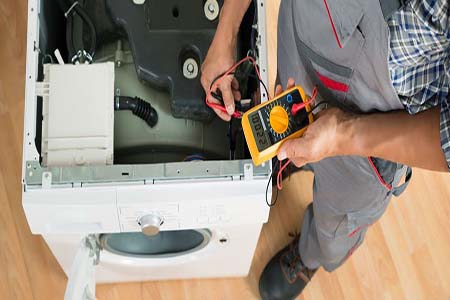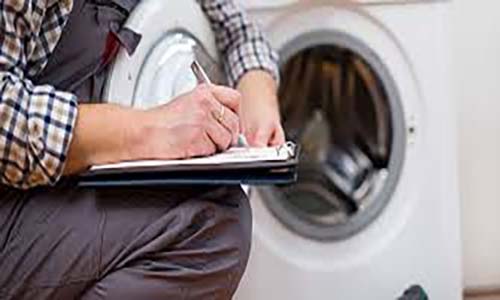Your dryer is an essential appliance in your home, especially when it comes to keeping your clothes clean and dry. But what do you do when your trusty dryer not spinning? Do not worry, In this guide, we’ll walk you through the steps to identify the problem and get your dryer working againf the most frequent culprits is the accumulation of lint within the dryer.
Safety First
Your safety should always be the first concern when dealing with any household appliance repair. Before you even think about troubleshooting your non-spinning dryer, follow these essential safety precautions:
- Unplug the dryer: First, unplug the dryer from the power source. This step is crucial to prevent electrical shock during your inspection and repair.
- Gas Dryers: If you have a gas dryer, also turn off the gas supply to the appliance. Gas leaks can be extremely dangerous, so make sure the gas valve is closed.
- Ventilation: Ensure the room where your dryer is located is well-ventilated. This helps dissipate any potentially harmful fumes, especially if you have a gas dryer.
- Protective Gear: Consider wearing protective gear, such as safety goggles and gloves, when working on your dryer. While it may seem like overkill for some tasks, it can prevent accidents and injury.
- Keep Children and Pets Away: Make sure children and pets are not in the vicinity while you’re working on your dryer. Keep them at a safe distance to avoid accidents.
- Avoid Wet Hands: Never touch any electrical components or connections with wet hands, as this increases the risk of electrical shock.
By following these safety measures, you’ll create a secure environment for troubleshooting and repairing your dryer.
Common Reasons for a Dryer Not Spinning

To effectively diagnose and fix the problem, you need to know the root causes of your dryer’s spinning problem. Here are some of the most common reasons your dryer may stop spinning:
- Power Supply Problems: Check if the dryer is receiving power. A blown fuse or tripped circuit breaker could be the issue.
- Faulty Start Switch: The start switch initiates the spinning process. If it’s malfunctioning, the dryer won’t start spinning.
- Broken Drive Belt: The drive belt connects the motor to the drum. if it’s damaged or broken, the drum won’t spin.
- Motor Issues: The motor is the heart of your dryer’s spinning mechanism. Motor problems can range from overheating to complete failure.
- Worn Drum Rollers: Drum rollers support the drum’s movement. If they’re worn out, the drum may not spin smoothly.
- Thermal Fuse Blown: The thermal fuse is a safety feature that disconnects the dryer from the power supply if it overheats..
- Lint Buildup: Excessive lint in the lint filter or vent can restrict airflow and cause the dryer to overheat and stop spinning
Tools and Materials You’ll Need
To effectively troubleshoot and repair your dryer, you will need the following tools and materials:
- Screwdrivers: Both flathead and Phillips screwdrivers will come in handy for opening panels and accessing components.
- Multimeter: This tool helps you check for electrical continuity and diagnose electrical problems.
- Replacement Parts: Depending on the issue you identify, you may need replacement parts such as a new drive belt, motor, or thermal fuse.
- Socket and Wrench Set: Useful for removing and replacing components, especially if you need to access the motor or drum rollers.
- Lint Brush or Vacuum Attachment: Lint brush or vacuum cleaner attachment: Essential for removing lint from the lint filter and dryer vent.
- Safety Gear: As mentioned earlier, consider safety goggles and gloves to protect yourself during the repair process.
With these tools and materials at your disposal, you’ll be well-prepared to tackle the troubleshooting process and, if necessary, the repair of your non-spinning dryer.
Step-by-Step Troubleshooting Guide
Now that you are equipped with the necessary tools and safety precautions, you can move on to the step-by-step troubleshooting guide for your non-spinning dryer. We will guide you through every stage of the process, ensuring you can effectively identify and resolve the issue.
Checking Power Supply

Our first step is to make sure your dryer has power and that there are no electrical issues causing the problem. Here’s what you should do:
Plug Inspection: Start by checking if the dryer is properly plugged into the electrical outlet. Sometimes, it might come loose over time.
Circuit Breaker or Fuse Box: Examine your home’s circuit breaker or fuse box. Look for a tripped breaker or a blown fuse related to the dryer circuit. If you find any, reset the breaker or replace the fuse.
Voltage Test: Use a multimeter to verify that the electrical outlet is providing the correct voltage. Dryers typically require 240 volts for proper operation.
Examining the Start Switch
A faulty start switch can be a straightforward cause of your dryer not spinning. Here’s how to inspect and potentially replace it:
Access the Start Switch: Depending on your dryer’s model, you may need to remove the control panel or rear panel to access the start switch.
Testing the Start Switch: Use a multimeter to check continuity when you press the start button. If there is no continuity, the switch is probably defective and needs to be replaced.
Replacement: If you determine that the start switch is defective, replace it with a compatible one following the manufacturer’s instructions.
Inspecting the Drive Belt
The drive belt connects the motor to the drum, enabling rotation. If it’s damaged or broken, your dryer won’t spin. Here’s how to check and replace it:
Access the Belt: Typically, you’ll need to open the dryer’s cabinet or front panel to access the belt.
Inspect the Belt: Look for any signs of wear, fraying, or damage on the drive belt. If it’s in poor condition, it should be replaced.
Replacement: To replace the belt, release the tension on the idler pulley or motor, remove the old belt, and install the new one according to your dryer’s specifications.
Assessing the Motor
A malfunctioning motor can be a major issue. Here’s how to test and replace the motor if necessary:
Access the Motor: Depending on your dryer’s design, you may need to remove the front or rear panel to access the motor.
Testing the Motor: Use a multimeter to test the motor for continuity. If it doesn’t show continuity, the motor may be defective and should be replaced.
Replacement: Replacing the engine may be more complex and may require disconnecting various components. Follow your dryer’s instruction manual or contact a professional if you are unsure.
Examining the Drum Rollers
Worn-out drum rollers can cause noisy and inefficient spinning. Here’s how to inspect and replace them:
Access the Rollers: You’ll typically need to remove the dryer’s front or rear panel to access the drum rollers.
Inspect the Rollers: Check for signs of wear or damage on the rollers. If they don’t turn smoothly, they should be replaced.
Replacement: Replace worn or damaged rollers with compatible replacement parts according to manufacturer’s guidelines.
Testing the Thermal Fuse
The thermal fuse is an important safety feature that can prevent your dryer from spinning if it burns out. How to test and replace it:
Locate the Thermal Fuse: The thermal fuse is usually found on the blower housing or exhaust duct.
Testing the Fuse: Use a multimeter to check the continuity of the thermal fuse. If it doesn’t show continuity, it needs replacement.
Replacement: Replace the blown thermal fuse with a new one, ensuring it matches your dryer’s specifications.
Cleaning the Lint Filter and Vent
A clogged lint filter or vent can restrict airflow and affect your dryer’s performance. Here’s how to clean them effectively:
Lint Filter: Remove the lint filter and clean it thoroughly with a brush or warm, soapy water. Allow it to dry before reinserting it.
Vent Cleaning: Disconnect the dryer from the vent and remove lint buildup from both the dryer vent and the external vent outlet with a lint brush or vacuum cleaner attachment. Make sure airflow is unobstructed.
By following these troubleshooting steps, you’ll have a clearer understanding of what’s causing your dryer’s spinning issue and be better equipped to resolve it. If the problem persists or you’re uncomfortable with the repair process, don’t hesitate to seek professional assistance.
Maintenance Tips to Prevent Future Issues

Preventative maintenance plays a crucial role in extending the life of your dryer and ensuring it continues to function smoothly. Here are some practical tips to help you maintain your dryer in top condition and avoid future spinning problems:
- Regularly Clean the Lint Filter: After each drying process, take out the lint filter and clean it. A clogged filter restricts airflow, which can lead to overheating and possible problems. Cleaning it takes only a few seconds and significantly reduces the risk of lint-related problems.
- Inspect and Clean the Ventilation System: Periodically check the dryer vent and exhaust duct for lint buildup. Disconnect the vent and use a lint brush or vacuum attachment to remove any accumulated lint. A clear ventilation system ensures efficient drying and reduces fire hazards.
- Balance the Load: Overloading your dryer can strain the motor and other components, leading to premature wear and tear. Follow the manufacturer’s guidelines for load capacity and avoid overloading your dryer to prevent spinning issues.
- Use Fabric Softener Sparingly: Excessive use of fabric softener can lead to a buildup of residue on the lint filter and inside the dryer. This can reduce airflow and affect spinning efficiency. Use fabric softener as recommended and clean the lint filter regularly to prevent this buildup.
- Inspect and Tighten Screws and Bolts: Vibrations during operation can cause screws and bolts to loosen over time. Periodically check the dryer’s exterior and interior for loose fasteners and tighten them as needed.
- Keep the Dryer Level: A dryer that is not level can lead to uneven wear on its components, including the drive belt. Use a leveling tool to ensure your dryer is on a stable and even surface.
- Avoid Overheating: Overheating can cause thermal fuses to blow and result in your dryer not spinning. To prevent this, avoid running your dryer at excessively high temperatures. If your dryer has adjustable heat settings, use them appropriately for different types of loads.
- Schedule Professional Maintenance: Consider scheduling annual or bi-annual professional maintenance for your dryer. A technician can inspect and clean internal components, ensuring optimal performance and catching potential issues before they become major problems.
- Keep the Area Around the Dryer Clean: Dust and debris around the dryer can be drawn into the appliance, affecting its operation. Regularly vacuum the area around the dryer and keep it free from clutter.
- Monitor Unusual Noises: If you notice unusual noises during the drying cycle, investigate promptly. Strange sounds can be an early indicator of a problem. Address any issues promptly to prevent further damage.
By following these maintenance tips, you can not only prevent future spinning problems but also extend the life of your dryer. Proper care and regular checks will keep your dryer running efficiently and reliably for years to come.